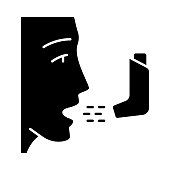Asthma Inhaler Procedures

Asthma inhalers are a lifesaver to many or if not all asthma sufferers. Asthma inhalers provides a safety net for people with asthma and is used whenever an asthma attack is about to happen.The most common asthma inhaler is a canister that deliver asthma medication.
A metered-dose inhaler (MDI) is a device that delivers a specific amount of medication to the lungs, in the form of a short burst of aerosolized medicine that is inhaled by the patient. It is the most commonly used delivery system for treating asthma,chronic obstructive pulmonary disease (COPD) and other respiratory diseases. The medication in a metered dose inhaler is most commonly a bronchodilator, corticosteroid or a combination of both for the treatment of asthma and COPD.
A metered-dose inhaler (MDI)
Asthma inhaler has been used for nearly a hundred years and has improved a lot in recent years to deliver greater absorption and potency. The basic principle is still the same although the medication has changed over the years.
When an asthma person suffers an asthma attack, the muscles in the bronchial tubes becomes constricted and thus makes it difficult for the person to breathe. An asthma inhaler helps to relax the muscles enabling the person to breathe normally. Doctors also recommend asthma sufferers to use inhalers before going to bed at night and also when they wake up in the morning.
People who use the asthma inhalers the first time may find it difficult to use at first. Although it looks simple, timing is very important. The mouthpiece is placed in the mouth and with a press of a button, you should breathe in hard at the same time so that the asthma medication can go into the lungs.
After the inhaler is released, you should exhale just as hard. It is important to get it right as during an asthma attack, a person may not have much time to think about it and should be able to do this instinctively.
By doing this in one motion, the full dosage of the medication is delivered to the lungs and you stand a better chance of recovering from an asthma attack.
More Explanation:
Inhalers may come with slightly different instructions. Follow those instructions carefully and ask your doctor for a demonstration.
Metered-dose inhalers:
These inhalers include a pressurized canister with measured doses of medication inside. Squeezing the top of the canister converts the medication into a fine mist. Some metered-dose inhalers are breath actuated and don’t require you to squeeze the inhaler.
You place your lips on or near the inhaler mouthpiece to inhale the mist.Using the type of metered-dose inhaler with a pressurized canister calls for coordinating two actions: squeezing the canister and inhaling the medication. You may find it easier to do this with a spacer — a short tube that attaches to the inhaler.
The spacer acts as a holding chamber that keeps the medication from escaping into the air. Releasing the medication into the chamber gives you time to inhale more slowly. It decreases the amount of medicine that’s deposited on the back of your throat and increases the amount that reaches your lungs.
Dry powder inhalers:
Dry powder inhalers require you to place your lips on the mouthpiece and inhale more rapidly than you would with a traditional metered-dose inhaler. Some people find dry powder inhalers easier to use than the conventional pressurized metered-dose inhalers because hand-lung coordination isn’t required.
Available types include a dry powder tube inhaler, a powder disk inhaler and a single dose dry powder disk inhaler. Spacers can’t be used with dry powder inhalers.
The importance of using inhalers properly:
Inhalers enable people with asthma to lead active lives without fear of an attack. Because inhalers are portable, they’re convenient and can provide immediate relief. But it’s important to use inhalers properly in order for the medications to be effective.
You may find it difficult to take asthma medication regularly, particularly corticosteroids or other medicines used to prevent asthma symptoms over the long term. You may not feel any immediate benefit from these medications. But if you don’t take them regularly, as prescribed, you may have problems later on. For example, you may rely too heavily on inhaled bronchodilators.
These fast-acting medications can relieve symptoms quickly, but they’re no substitute for the long-term medications that keep your asthma under control.
In addition to taking the medications you’re prescribed, it’s important that you use your inhaler(s) correctly so that the medication reaches your lungs. Carefully follow the instructions. And ask a doctor, nurse or pharmacist for a demonstration. Use the inhaler in front of this person and ask for feedback. Then practice at home in front of a mirror.
If you’re unable to use an inhaler, a nebulizer may be an option. Nebulizers are designed for those who can’t use an inhaler, such as infants, young children and those who are seriously ill. The device works by converting medication into a mist and delivering it through a mask that you wear over your nose and mouth.
Medications delivered through inhalers:
Asthma inhalers are used to deliver a variety of asthma medications — some that assist with long-term control and others that provide quick relief of symptoms.
Inhaled asthma medications include:
- Short-acting bronchodilators. These medications, including albuterol (Proventil, Ventolin) and pirbuterol (Maxair), provide immediate relief of asthma symptoms.
- Long-acting bronchodilators. These medications relieve asthma symptoms for longer periods of time. They include salmeterol (Serevent) and formoterol (Foradil).
- Corticosteroids. Used long term to prevent asthma attacks, these medications include beclomethasone dipropionate (QVAR), fluticasone (Flovent), budesonide (Pulmicort), triamcinolone acetonide (Azmacort) and flunisolide (Aerobid).
- Cromolyn or nedocromil. These nonsteroidal medications are used long term to prevent inflammation.
- Corticosteroid plus long-acting bronchodilator. This medication combines a corticosteroid and a long-acting bronchodilator (Advair).
Since no permanent cure for asthma ,as such asthma inhalers are a very valuable lifesaver that has helped save many people’s lives.
Comments
Post a Comment